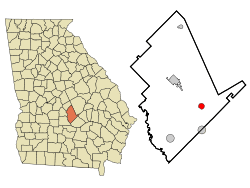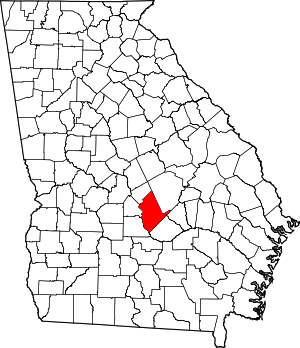Chauncey, Georgia
Chauncey is a city in Dodge County, Georgia, United States. The population was 342 at the 2010 census.[5] It was formed around station number twelve on the Macon and Brunswick Railroad.
Chauncey, Georgia | |
|---|---|
Chauncey City Hall at Old Chauncey School | |
 Location in Dodge County and the state of Georgia | |
| Coordinates: 32°6′18″N 83°3′58″W | |
| Country | United States |
| State | Georgia |
| County | Dodge |
| Area | |
| • Total | 1.73 sq mi (4.47 km2) |
| • Land | 1.73 sq mi (4.47 km2) |
| • Water | 0.00 sq mi (0.00 km2) |
| Elevation | 308 ft (94 m) |
| Population (2010) | |
| • Total | 342 |
| • Estimate (2019)[2] | 326 |
| • Density | 188.88/sq mi (72.94/km2) |
| Time zone | UTC-5 (Eastern (EST)) |
| • Summer (DST) | UTC-4 (EDT) |
| ZIP code | 31011 |
| Area code(s) | 478 |
| FIPS code | 13-15648[3] |
| GNIS feature ID | 0312593[4] |
History
The Georgia General Assembly incorporated the "Town of Chauncey" in 1883.[6] The community was named after William Chauncey, a businessperson in the local lumber industry.[7]
Geography
Chauncey is located in southeastern Dodge County at 32°6′18″N 83°3′58″W (32.104972, -83.065991).[8] U.S. Routes 23 and 341 pass concurrently through the center of town, leading northwest 9 miles (14 km) to Eastman, the county seat, and east 10 miles (16 km) to McRae. Sugar Creek runs along the southwest border of the city.
According to the United States Census Bureau, Chauncey has a total area of 1.7 square miles (4.5 km2), all of it land.[5]
Demographics
| Historical population | |||
|---|---|---|---|
| Census | Pop. | %± | |
| 1890 | 683 | — | |
| 1900 | 422 | −38.2% | |
| 1910 | 350 | −17.1% | |
| 1920 | 408 | 16.6% | |
| 1930 | 397 | −2.7% | |
| 1940 | 387 | −2.5% | |
| 1950 | 348 | −10.1% | |
| 1960 | 330 | −5.2% | |
| 1970 | 308 | −6.7% | |
| 1980 | 350 | 13.6% | |
| 1990 | 312 | −10.9% | |
| 2000 | 295 | −5.4% | |
| 2010 | 342 | 15.9% | |
| Est. 2019 | 326 | [2] | −4.7% |
| U.S. Decennial Census[9] | |||
As of the census[3] of 2000, there were 295 people, 111 households, and 85 families residing in the town. The population density was 170.6 people per square mile (65.8/km2). There were 125 housing units at an average density of 72.3 per square mile (27.9/km2). The racial makeup of the town was 58.98% White, 39.32% African American and 1.69% Native American. Hispanic or Latino of any race were 0.34% of the population.
There were 111 households, out of which 36.9% had children under the age of 18 living with them, 50.5% were married couples living together, 23.4% had a female householder with no husband present, and 23.4% were non-families. 22.5% of all households were made up of individuals, and 9.0% had someone living alone who was 65 years of age or older. The average household size was 2.66 and the average family size was 3.13.
In the town the population was spread out, with 29.8% under the age of 18, 7.1% from 18 to 24, 24.4% from 25 to 44, 24.7% from 45 to 64, and 13.9% who were 65 years of age or older. The median age was 36 years. For every 100 females, there were 102.1 males. For every 100 females age 18 and over, there were 81.6 males.
The median income for a household in the town was $26,818, and the median income for a family was $29,500. Males had a median income of $22,813 versus $20,625 for females. The per capita income for the town was $12,600. About 17.5% of families and 17.8% of the population were below the poverty line, including 21.4% of those under the age of eighteen and 15.6% of those 65 or over.
References
- "2019 U.S. Gazetteer Files". United States Census Bureau. Retrieved July 9, 2020.
- "Population and Housing Unit Estimates". United States Census Bureau. May 24, 2020. Retrieved May 27, 2020.
- "U.S. Census website". United States Census Bureau. Retrieved 2008-01-31.
- "US Board on Geographic Names". United States Geological Survey. 2007-10-25. Retrieved 2008-01-31.
- "Geographic Identifiers: 2010 Demographic Profile Data (G001): Chauncey city, Georgia". U.S. Census Bureau, American Factfinder. Retrieved October 21, 2015.
- Acts of the General Assembly of the State of Georgia. Clark & Hines, State Printers. 1889. p. 824.
- Krakow, Kenneth K. (1975). Georgia Place-Names: Their History and Origins (PDF). Macon, GA: Winship Press. p. 41. ISBN 0-915430-00-2.
- "US Gazetteer files: 2010, 2000, and 1990". United States Census Bureau. 2011-02-12. Retrieved 2011-04-23.
- "Census of Population and Housing". Census.gov. Retrieved June 4, 2015.
